Effective Conflict Resolution Strategies in a Nursing Care Setting
VerifiedAdded on 2022/08/27
|7
|1693
|19
Report
AI Summary
This report provides a comprehensive analysis of a conflict observed in a nursing care setting. The paper begins with an introduction highlighting the significance of conflict resolution in healthcare, focusing on the impact of interpersonal conflicts on patient care and team dynamics. The core of the report details a specific scenario involving nurses in an emergency care hospital, where a junior nurse's concerns about a patient's deteriorating condition are dismissed by senior staff, leading to an unresolved conflict. The report then delves into the four stages of conflict according to Finkelman (2015), applying these stages to the described scenario. Finally, the report proposes and justifies a collaborative strategy, involving the nurse leader, as the most effective approach to resolving the conflict and ensuring better patient outcomes. The rationale emphasizes the need for experienced guidance and effective communication to improve teamwork and prevent potential harm to patients. References are provided to support the analysis and recommendations.
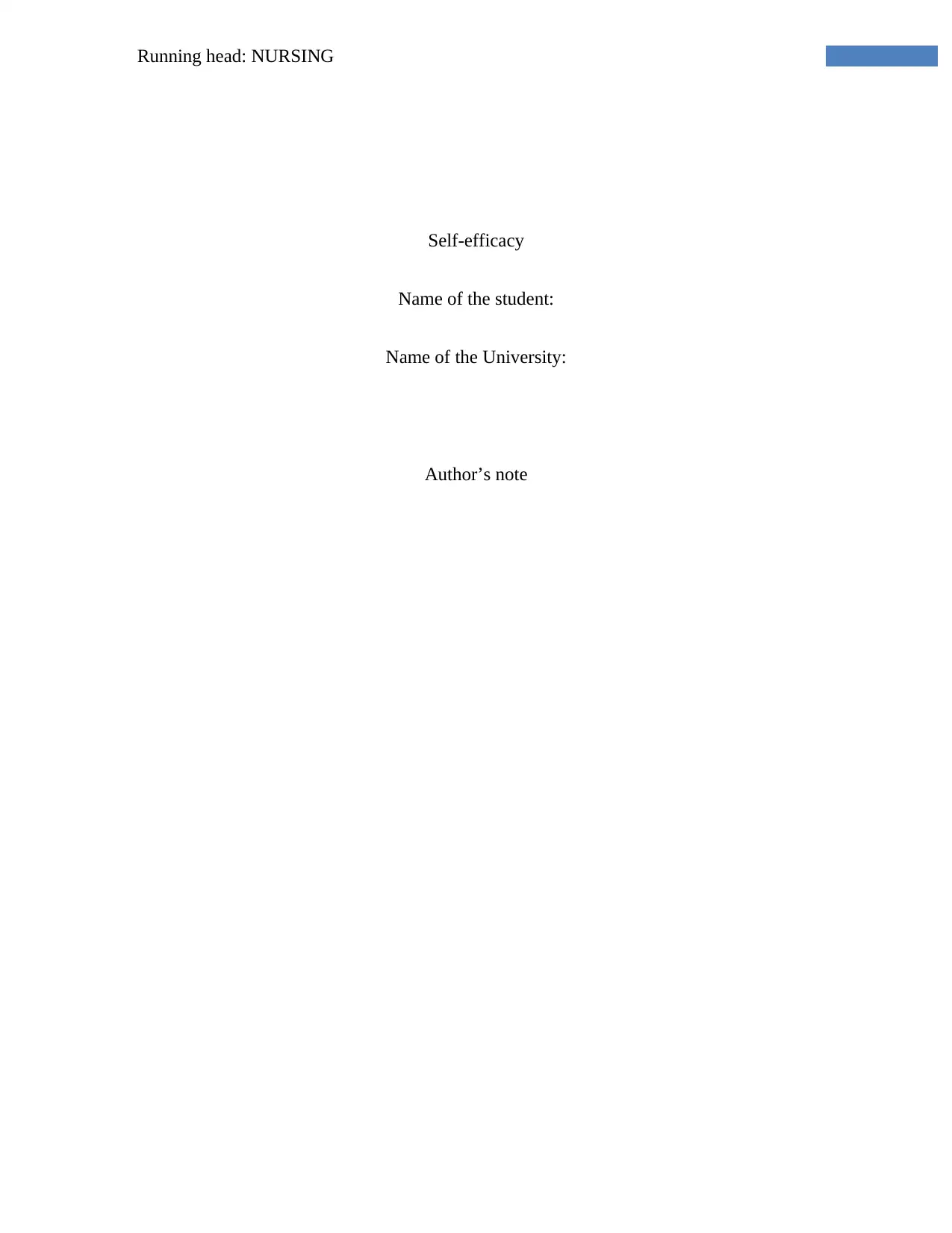
Running head: NURSING
Self-efficacy
Name of the student:
Name of the University:
Author’s note
Self-efficacy
Name of the student:
Name of the University:
Author’s note
Paraphrase This Document
Need a fresh take? Get an instant paraphrase of this document with our AI Paraphraser
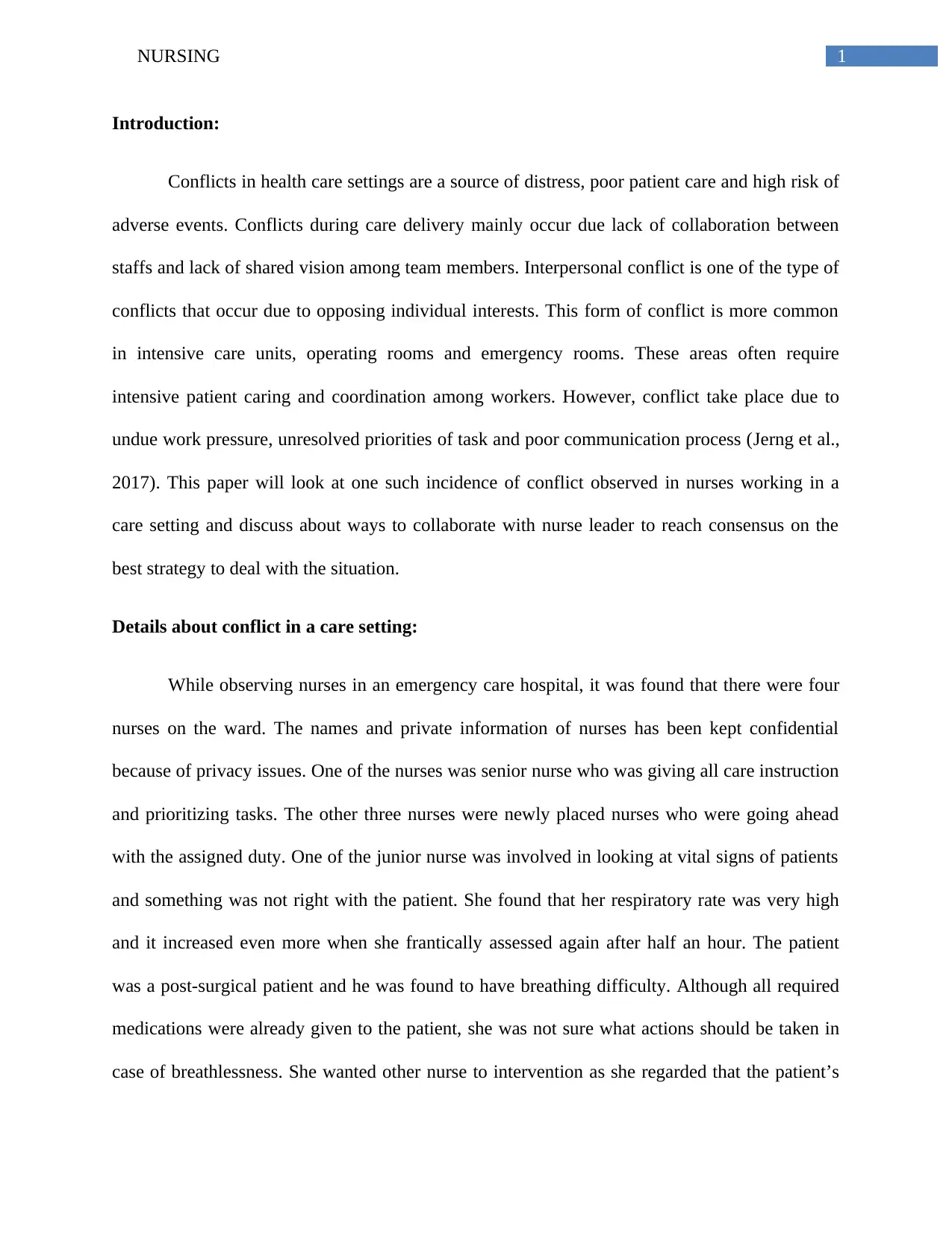
1NURSING
Introduction:
Conflicts in health care settings are a source of distress, poor patient care and high risk of
adverse events. Conflicts during care delivery mainly occur due lack of collaboration between
staffs and lack of shared vision among team members. Interpersonal conflict is one of the type of
conflicts that occur due to opposing individual interests. This form of conflict is more common
in intensive care units, operating rooms and emergency rooms. These areas often require
intensive patient caring and coordination among workers. However, conflict take place due to
undue work pressure, unresolved priorities of task and poor communication process (Jerng et al.,
2017). This paper will look at one such incidence of conflict observed in nurses working in a
care setting and discuss about ways to collaborate with nurse leader to reach consensus on the
best strategy to deal with the situation.
Details about conflict in a care setting:
While observing nurses in an emergency care hospital, it was found that there were four
nurses on the ward. The names and private information of nurses has been kept confidential
because of privacy issues. One of the nurses was senior nurse who was giving all care instruction
and prioritizing tasks. The other three nurses were newly placed nurses who were going ahead
with the assigned duty. One of the junior nurse was involved in looking at vital signs of patients
and something was not right with the patient. She found that her respiratory rate was very high
and it increased even more when she frantically assessed again after half an hour. The patient
was a post-surgical patient and he was found to have breathing difficulty. Although all required
medications were already given to the patient, she was not sure what actions should be taken in
case of breathlessness. She wanted other nurse to intervention as she regarded that the patient’s
Introduction:
Conflicts in health care settings are a source of distress, poor patient care and high risk of
adverse events. Conflicts during care delivery mainly occur due lack of collaboration between
staffs and lack of shared vision among team members. Interpersonal conflict is one of the type of
conflicts that occur due to opposing individual interests. This form of conflict is more common
in intensive care units, operating rooms and emergency rooms. These areas often require
intensive patient caring and coordination among workers. However, conflict take place due to
undue work pressure, unresolved priorities of task and poor communication process (Jerng et al.,
2017). This paper will look at one such incidence of conflict observed in nurses working in a
care setting and discuss about ways to collaborate with nurse leader to reach consensus on the
best strategy to deal with the situation.
Details about conflict in a care setting:
While observing nurses in an emergency care hospital, it was found that there were four
nurses on the ward. The names and private information of nurses has been kept confidential
because of privacy issues. One of the nurses was senior nurse who was giving all care instruction
and prioritizing tasks. The other three nurses were newly placed nurses who were going ahead
with the assigned duty. One of the junior nurse was involved in looking at vital signs of patients
and something was not right with the patient. She found that her respiratory rate was very high
and it increased even more when she frantically assessed again after half an hour. The patient
was a post-surgical patient and he was found to have breathing difficulty. Although all required
medications were already given to the patient, she was not sure what actions should be taken in
case of breathlessness. She wanted other nurse to intervention as she regarded that the patient’s
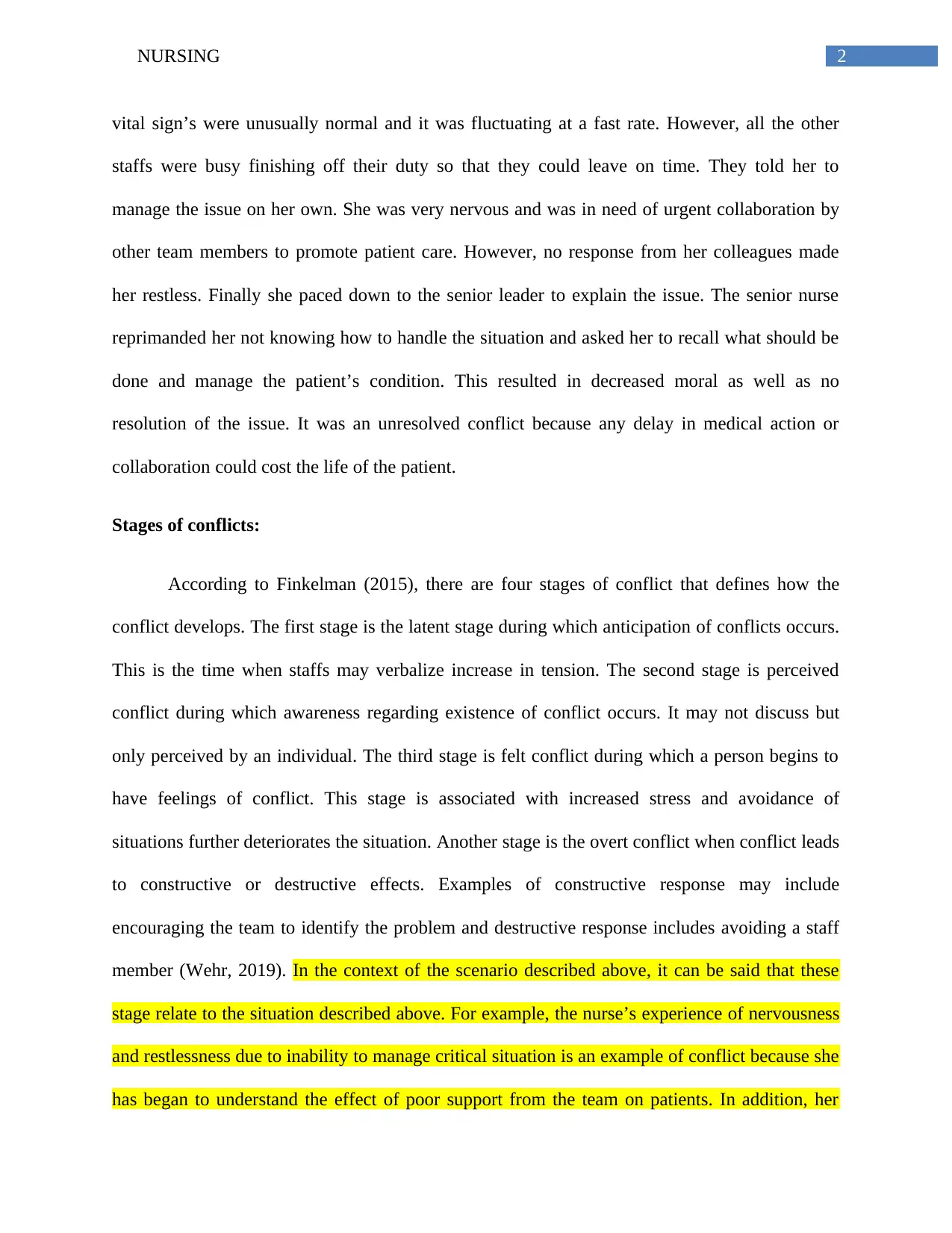
2NURSING
vital sign’s were unusually normal and it was fluctuating at a fast rate. However, all the other
staffs were busy finishing off their duty so that they could leave on time. They told her to
manage the issue on her own. She was very nervous and was in need of urgent collaboration by
other team members to promote patient care. However, no response from her colleagues made
her restless. Finally she paced down to the senior leader to explain the issue. The senior nurse
reprimanded her not knowing how to handle the situation and asked her to recall what should be
done and manage the patient’s condition. This resulted in decreased moral as well as no
resolution of the issue. It was an unresolved conflict because any delay in medical action or
collaboration could cost the life of the patient.
Stages of conflicts:
According to Finkelman (2015), there are four stages of conflict that defines how the
conflict develops. The first stage is the latent stage during which anticipation of conflicts occurs.
This is the time when staffs may verbalize increase in tension. The second stage is perceived
conflict during which awareness regarding existence of conflict occurs. It may not discuss but
only perceived by an individual. The third stage is felt conflict during which a person begins to
have feelings of conflict. This stage is associated with increased stress and avoidance of
situations further deteriorates the situation. Another stage is the overt conflict when conflict leads
to constructive or destructive effects. Examples of constructive response may include
encouraging the team to identify the problem and destructive response includes avoiding a staff
member (Wehr, 2019). In the context of the scenario described above, it can be said that these
stage relate to the situation described above. For example, the nurse’s experience of nervousness
and restlessness due to inability to manage critical situation is an example of conflict because she
has began to understand the effect of poor support from the team on patients. In addition, her
vital sign’s were unusually normal and it was fluctuating at a fast rate. However, all the other
staffs were busy finishing off their duty so that they could leave on time. They told her to
manage the issue on her own. She was very nervous and was in need of urgent collaboration by
other team members to promote patient care. However, no response from her colleagues made
her restless. Finally she paced down to the senior leader to explain the issue. The senior nurse
reprimanded her not knowing how to handle the situation and asked her to recall what should be
done and manage the patient’s condition. This resulted in decreased moral as well as no
resolution of the issue. It was an unresolved conflict because any delay in medical action or
collaboration could cost the life of the patient.
Stages of conflicts:
According to Finkelman (2015), there are four stages of conflict that defines how the
conflict develops. The first stage is the latent stage during which anticipation of conflicts occurs.
This is the time when staffs may verbalize increase in tension. The second stage is perceived
conflict during which awareness regarding existence of conflict occurs. It may not discuss but
only perceived by an individual. The third stage is felt conflict during which a person begins to
have feelings of conflict. This stage is associated with increased stress and avoidance of
situations further deteriorates the situation. Another stage is the overt conflict when conflict leads
to constructive or destructive effects. Examples of constructive response may include
encouraging the team to identify the problem and destructive response includes avoiding a staff
member (Wehr, 2019). In the context of the scenario described above, it can be said that these
stage relate to the situation described above. For example, the nurse’s experience of nervousness
and restlessness due to inability to manage critical situation is an example of conflict because she
has began to understand the effect of poor support from the team on patients. In addition, her
⊘ This is a preview!⊘
Do you want full access?
Subscribe today to unlock all pages.

Trusted by 1+ million students worldwide
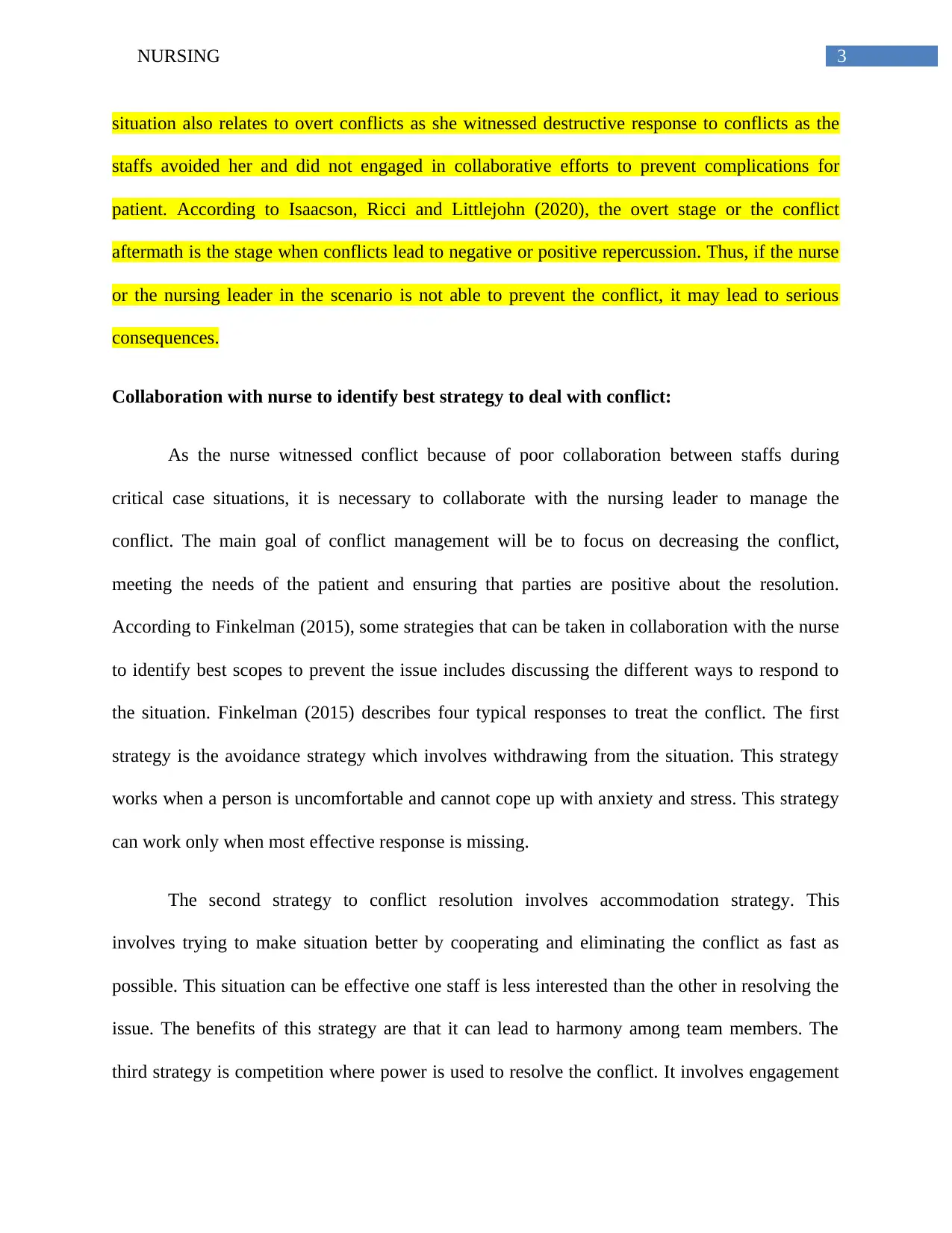
3NURSING
situation also relates to overt conflicts as she witnessed destructive response to conflicts as the
staffs avoided her and did not engaged in collaborative efforts to prevent complications for
patient. According to Isaacson, Ricci and Littlejohn (2020), the overt stage or the conflict
aftermath is the stage when conflicts lead to negative or positive repercussion. Thus, if the nurse
or the nursing leader in the scenario is not able to prevent the conflict, it may lead to serious
consequences.
Collaboration with nurse to identify best strategy to deal with conflict:
As the nurse witnessed conflict because of poor collaboration between staffs during
critical case situations, it is necessary to collaborate with the nursing leader to manage the
conflict. The main goal of conflict management will be to focus on decreasing the conflict,
meeting the needs of the patient and ensuring that parties are positive about the resolution.
According to Finkelman (2015), some strategies that can be taken in collaboration with the nurse
to identify best scopes to prevent the issue includes discussing the different ways to respond to
the situation. Finkelman (2015) describes four typical responses to treat the conflict. The first
strategy is the avoidance strategy which involves withdrawing from the situation. This strategy
works when a person is uncomfortable and cannot cope up with anxiety and stress. This strategy
can work only when most effective response is missing.
The second strategy to conflict resolution involves accommodation strategy. This
involves trying to make situation better by cooperating and eliminating the conflict as fast as
possible. This situation can be effective one staff is less interested than the other in resolving the
issue. The benefits of this strategy are that it can lead to harmony among team members. The
third strategy is competition where power is used to resolve the conflict. It involves engagement
situation also relates to overt conflicts as she witnessed destructive response to conflicts as the
staffs avoided her and did not engaged in collaborative efforts to prevent complications for
patient. According to Isaacson, Ricci and Littlejohn (2020), the overt stage or the conflict
aftermath is the stage when conflicts lead to negative or positive repercussion. Thus, if the nurse
or the nursing leader in the scenario is not able to prevent the conflict, it may lead to serious
consequences.
Collaboration with nurse to identify best strategy to deal with conflict:
As the nurse witnessed conflict because of poor collaboration between staffs during
critical case situations, it is necessary to collaborate with the nursing leader to manage the
conflict. The main goal of conflict management will be to focus on decreasing the conflict,
meeting the needs of the patient and ensuring that parties are positive about the resolution.
According to Finkelman (2015), some strategies that can be taken in collaboration with the nurse
to identify best scopes to prevent the issue includes discussing the different ways to respond to
the situation. Finkelman (2015) describes four typical responses to treat the conflict. The first
strategy is the avoidance strategy which involves withdrawing from the situation. This strategy
works when a person is uncomfortable and cannot cope up with anxiety and stress. This strategy
can work only when most effective response is missing.
The second strategy to conflict resolution involves accommodation strategy. This
involves trying to make situation better by cooperating and eliminating the conflict as fast as
possible. This situation can be effective one staff is less interested than the other in resolving the
issue. The benefits of this strategy are that it can lead to harmony among team members. The
third strategy is competition where power is used to resolve the conflict. It involves engagement
Paraphrase This Document
Need a fresh take? Get an instant paraphrase of this document with our AI Paraphraser
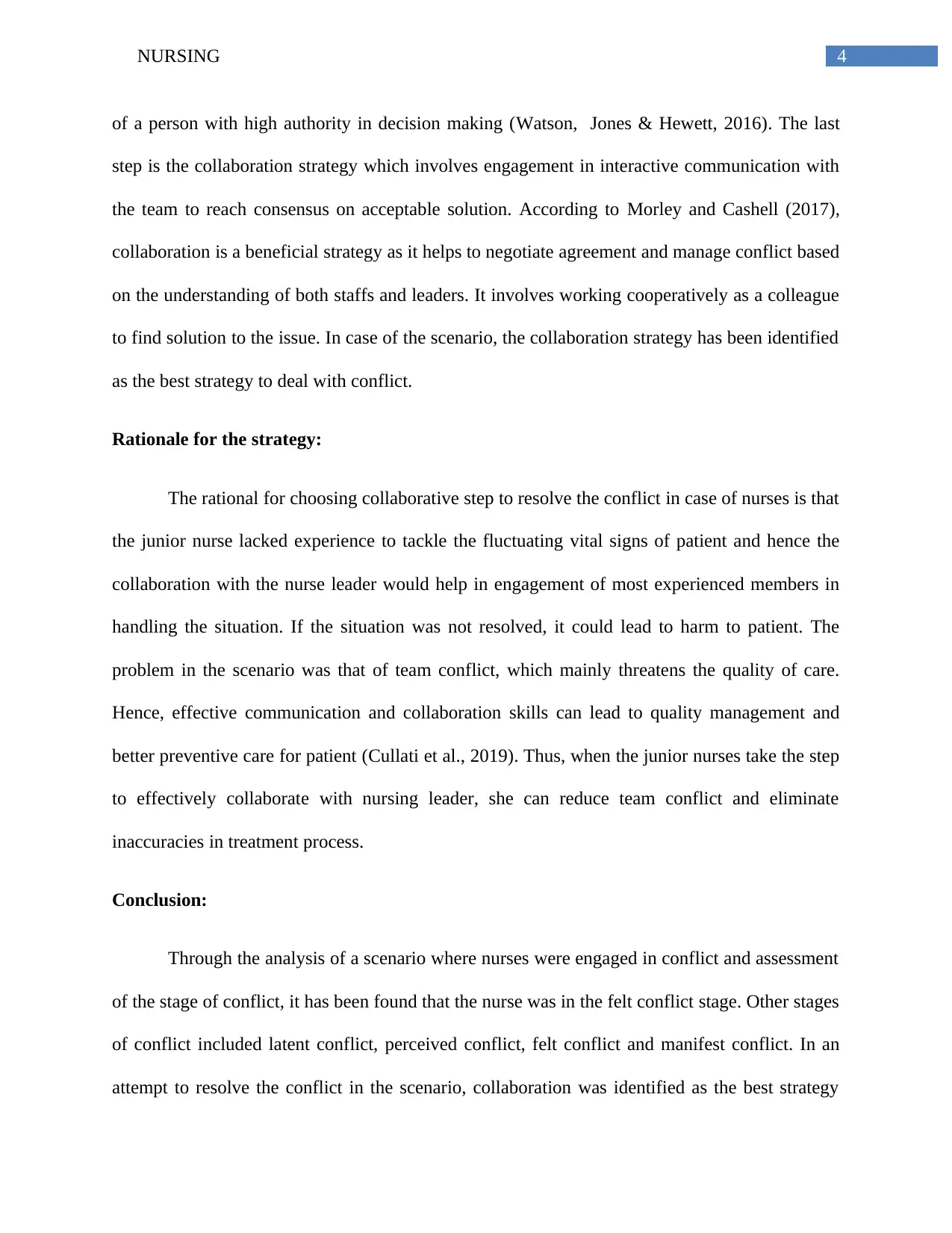
4NURSING
of a person with high authority in decision making (Watson, Jones & Hewett, 2016). The last
step is the collaboration strategy which involves engagement in interactive communication with
the team to reach consensus on acceptable solution. According to Morley and Cashell (2017),
collaboration is a beneficial strategy as it helps to negotiate agreement and manage conflict based
on the understanding of both staffs and leaders. It involves working cooperatively as a colleague
to find solution to the issue. In case of the scenario, the collaboration strategy has been identified
as the best strategy to deal with conflict.
Rationale for the strategy:
The rational for choosing collaborative step to resolve the conflict in case of nurses is that
the junior nurse lacked experience to tackle the fluctuating vital signs of patient and hence the
collaboration with the nurse leader would help in engagement of most experienced members in
handling the situation. If the situation was not resolved, it could lead to harm to patient. The
problem in the scenario was that of team conflict, which mainly threatens the quality of care.
Hence, effective communication and collaboration skills can lead to quality management and
better preventive care for patient (Cullati et al., 2019). Thus, when the junior nurses take the step
to effectively collaborate with nursing leader, she can reduce team conflict and eliminate
inaccuracies in treatment process.
Conclusion:
Through the analysis of a scenario where nurses were engaged in conflict and assessment
of the stage of conflict, it has been found that the nurse was in the felt conflict stage. Other stages
of conflict included latent conflict, perceived conflict, felt conflict and manifest conflict. In an
attempt to resolve the conflict in the scenario, collaboration was identified as the best strategy
of a person with high authority in decision making (Watson, Jones & Hewett, 2016). The last
step is the collaboration strategy which involves engagement in interactive communication with
the team to reach consensus on acceptable solution. According to Morley and Cashell (2017),
collaboration is a beneficial strategy as it helps to negotiate agreement and manage conflict based
on the understanding of both staffs and leaders. It involves working cooperatively as a colleague
to find solution to the issue. In case of the scenario, the collaboration strategy has been identified
as the best strategy to deal with conflict.
Rationale for the strategy:
The rational for choosing collaborative step to resolve the conflict in case of nurses is that
the junior nurse lacked experience to tackle the fluctuating vital signs of patient and hence the
collaboration with the nurse leader would help in engagement of most experienced members in
handling the situation. If the situation was not resolved, it could lead to harm to patient. The
problem in the scenario was that of team conflict, which mainly threatens the quality of care.
Hence, effective communication and collaboration skills can lead to quality management and
better preventive care for patient (Cullati et al., 2019). Thus, when the junior nurses take the step
to effectively collaborate with nursing leader, she can reduce team conflict and eliminate
inaccuracies in treatment process.
Conclusion:
Through the analysis of a scenario where nurses were engaged in conflict and assessment
of the stage of conflict, it has been found that the nurse was in the felt conflict stage. Other stages
of conflict included latent conflict, perceived conflict, felt conflict and manifest conflict. In an
attempt to resolve the conflict in the scenario, collaboration was identified as the best strategy

5NURSING
because the nurse suffered because she did not received support from her team member.
Collaboration would help her get the support needed to tackle critical care situations.
because the nurse suffered because she did not received support from her team member.
Collaboration would help her get the support needed to tackle critical care situations.
⊘ This is a preview!⊘
Do you want full access?
Subscribe today to unlock all pages.

Trusted by 1+ million students worldwide
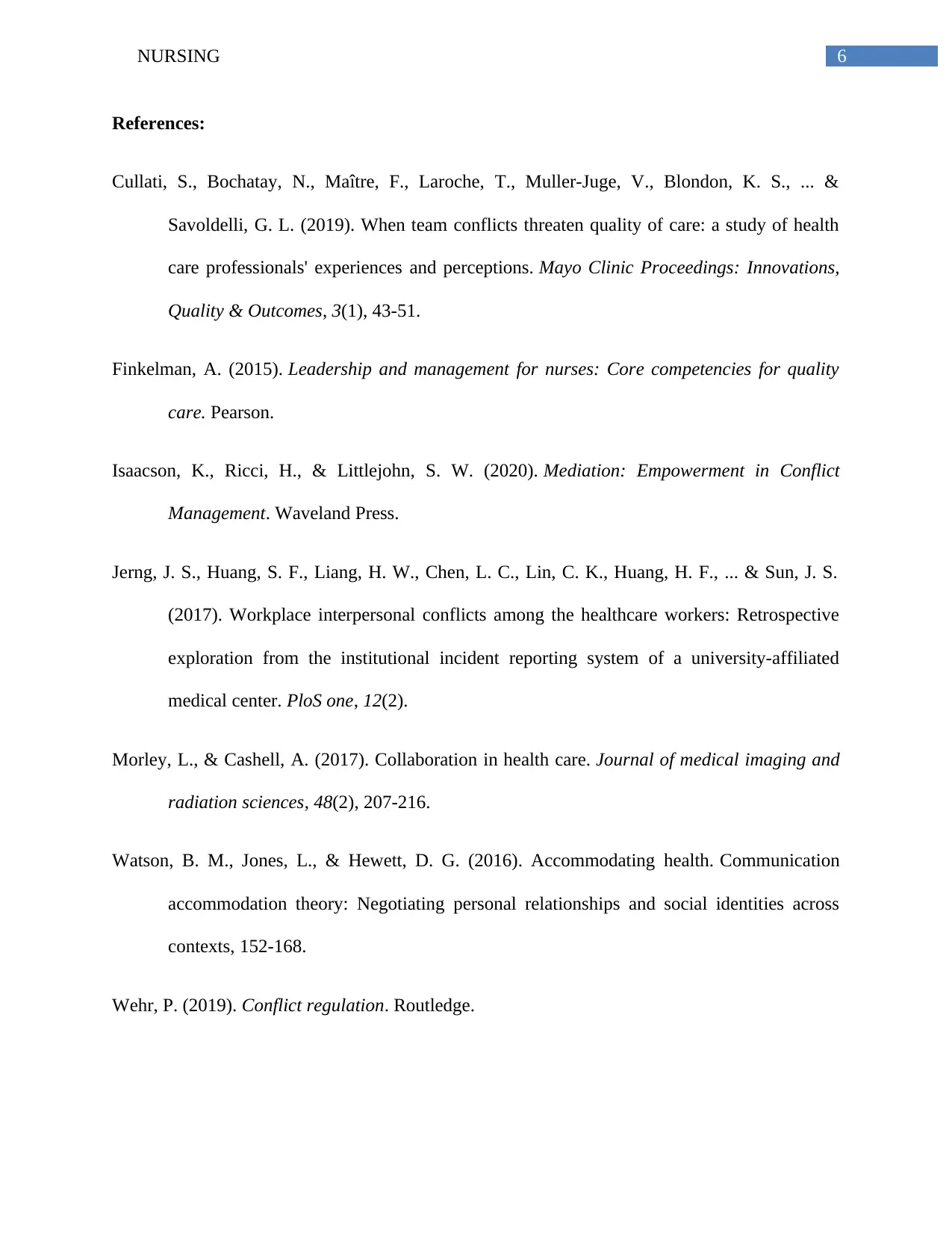
6NURSING
References:
Cullati, S., Bochatay, N., Maître, F., Laroche, T., Muller-Juge, V., Blondon, K. S., ... &
Savoldelli, G. L. (2019). When team conflicts threaten quality of care: a study of health
care professionals' experiences and perceptions. Mayo Clinic Proceedings: Innovations,
Quality & Outcomes, 3(1), 43-51.
Finkelman, A. (2015). Leadership and management for nurses: Core competencies for quality
care. Pearson.
Isaacson, K., Ricci, H., & Littlejohn, S. W. (2020). Mediation: Empowerment in Conflict
Management. Waveland Press.
Jerng, J. S., Huang, S. F., Liang, H. W., Chen, L. C., Lin, C. K., Huang, H. F., ... & Sun, J. S.
(2017). Workplace interpersonal conflicts among the healthcare workers: Retrospective
exploration from the institutional incident reporting system of a university-affiliated
medical center. PloS one, 12(2).
Morley, L., & Cashell, A. (2017). Collaboration in health care. Journal of medical imaging and
radiation sciences, 48(2), 207-216.
Watson, B. M., Jones, L., & Hewett, D. G. (2016). Accommodating health. Communication
accommodation theory: Negotiating personal relationships and social identities across
contexts, 152-168.
Wehr, P. (2019). Conflict regulation. Routledge.
References:
Cullati, S., Bochatay, N., Maître, F., Laroche, T., Muller-Juge, V., Blondon, K. S., ... &
Savoldelli, G. L. (2019). When team conflicts threaten quality of care: a study of health
care professionals' experiences and perceptions. Mayo Clinic Proceedings: Innovations,
Quality & Outcomes, 3(1), 43-51.
Finkelman, A. (2015). Leadership and management for nurses: Core competencies for quality
care. Pearson.
Isaacson, K., Ricci, H., & Littlejohn, S. W. (2020). Mediation: Empowerment in Conflict
Management. Waveland Press.
Jerng, J. S., Huang, S. F., Liang, H. W., Chen, L. C., Lin, C. K., Huang, H. F., ... & Sun, J. S.
(2017). Workplace interpersonal conflicts among the healthcare workers: Retrospective
exploration from the institutional incident reporting system of a university-affiliated
medical center. PloS one, 12(2).
Morley, L., & Cashell, A. (2017). Collaboration in health care. Journal of medical imaging and
radiation sciences, 48(2), 207-216.
Watson, B. M., Jones, L., & Hewett, D. G. (2016). Accommodating health. Communication
accommodation theory: Negotiating personal relationships and social identities across
contexts, 152-168.
Wehr, P. (2019). Conflict regulation. Routledge.
1 out of 7
Related Documents
Your All-in-One AI-Powered Toolkit for Academic Success.
+13062052269
info@desklib.com
Available 24*7 on WhatsApp / Email
![[object Object]](/_next/static/media/star-bottom.7253800d.svg)
Unlock your academic potential
Copyright © 2020–2025 A2Z Services. All Rights Reserved. Developed and managed by ZUCOL.





